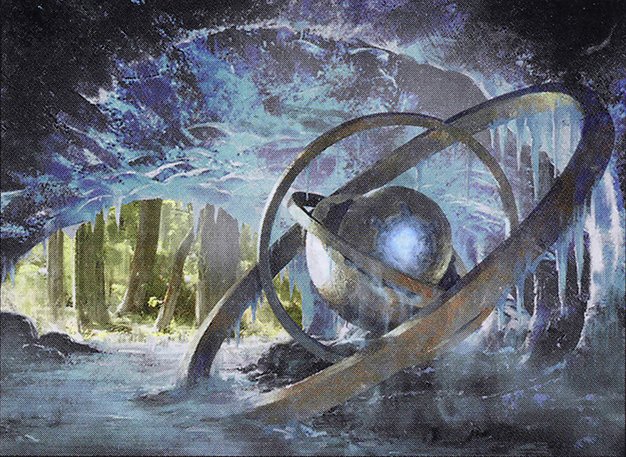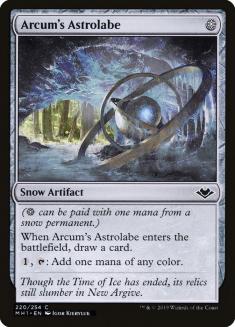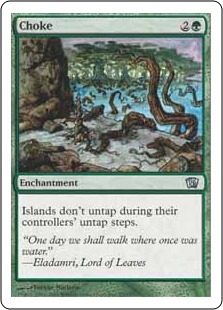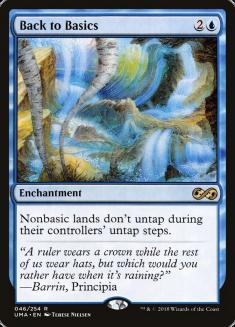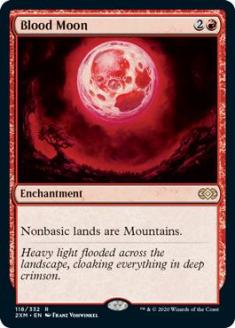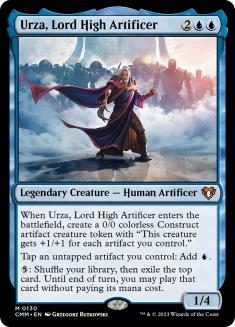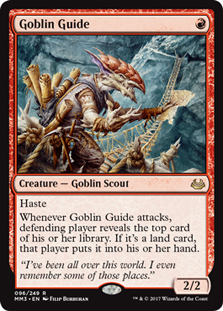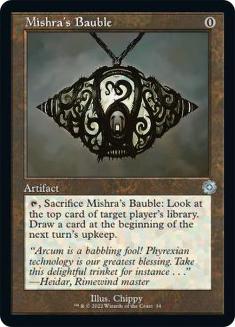My love for the Eternal formats of Magic is undying, even during the dark periods when they’re at their worst. Even when there’s something truly broken going on, the financial investment required, deep card pool, and dedicated archetype players that show up to all the events produce a tolerable level of diversity. Few players can ditch their beloved Bant Infect deck to craft Grinding Breach, and even if they were able to, most don’t want to.
You become attached to the cards that you’ve cast since childhood, as well as financially locked to a few different decks that share a similar card pool. This is what has made Modern and Legacy popular formats since their inception. Even with the resiliency of these older formats, many players want format health restored so they can achieve maximum satisfaction in their Magic Online (MTGO) League, Friday Night Magic (FNM), or premium event of choice.
There’s a weak argument that nothing needs to change and everything is great in Modern and Legacy. Skeptics will point at deck diversity, ignoring the variables I just laid out. Even if a major Modern event had a Top 8 with eight different decks, the format could still be in desperate need of assistance.
In this hypothetical Top 8, five of the decks would likely have Arcum’s Astrolabe, with the other three decks being different flavors of Prowess. Each of these Top 8 decks would have four Mishra’s Baubles in them, as that card seems to be in every deck in the format. I would identify this Top 8 as an exhibit of deckbuilding restrictions and homogeneous card choices, strangling the format of true creativity. Variety in decklists is not based on title, but on the ability to play an array of different strategies, with different cards, using a deep card pool.
Wizards of the Coast (WotC) has tried to fix the Modern problem for a while, reducing the speed of the format and slashing homogeneous deckbuilding with targeted strikes. Oko, Thief of Crowns is a perfect example of a card that became a must-include in each deck in the format, stifling the creature-based decks of the format and creating one of the stalest metagames in recent history.
I respect pushing the boundaries of card development, even though it guarantees a greater number of bannings with it. This wave of new cards has done just that, especially with the onslaught of companions. We just saw some remedies come out Monday for the older formats, but the elephant in the room remains. When it comes to homogeneous deck building and stale matchups in Modern and Legacy, look no further than Arcum’s Astrolabe.
In Legacy, Arcum’s Astrolabe has ground the format to a halt. I have never been a fan of having my lands targeted by Wasteland; however, it has become abundantly clear why that interaction was a format positive. The different deck designs, talent to navigate, existence of aggro, and only chance of nonblue decks all centered around this one card. Wasteland was the check on players, making sure an adequate punishment exists for those all-in on nonbasic lands. Death and Taxes, Mono-Red Prison, Temur Delver, and Lands were viable at the core from their ability to knock off blue decks that were close to unstoppable if their mana cooperated.
Wasteland is still a legal and played card in Legacy, but Arcum’s Astrolabe has completely redefined mana. There’s no punishment for running a bunch of colors with basic lands to cast them. Before Arcum’s Astrolabe, the cost of multicolor business in Legacy was the threat of not being able to cast spells. Wasteland teamed with Choke, Back to Basics, and Blood Moon to heavily pressure the dominant Brainstorm decks. These proactive answers to the best decks in the format are now jokes, as Arcum’s Astrolabe pushes each closer to irrelevancy.
With a card pool as deep as Legacy has, there have been mana fixers that provide some cover against the sea of hatred that’s out there. None of these fixers have ever been close to playable due to cost and effect. Arcum’s Astrolabe costs only one mana and draws a card when it enters the battlefield. This is an outrageous package that requires little additional cost outside of playing Snow-Covered lands over normal basics.
The moment this card was released in Modern Horizons, I knew it would be a game-changer for both Modern and Legacy. I remember the nervousness that overcame me when I led out with a Tundra to have both Sword to Plowshare and Spell Pierce open. That opening play was often not my go-to because of the threats I discussed. More often, I would play the Island and take my beats like a champ, just to be cautious and not lose my white source immediately. This is just one example of thousands where Wasteland provided full cover and strength for the weaker nonblue decks, and even when they were used in blue decks, they were often accompanied by Delver of Secrets.
The aggro element of Legacy is close to dead. I have never seen it this bad in my decades of playing the format. Aggro has rarely been great in the older formats; however, it was at least competitive most of the time. With the format being ruled by Oko and multicolor Arcum’s Astrolabe decks, there’s nowhere to hide for one-drop creatures. Oko is another killer for the format, but it would be significantly weakened by an Arcum’s Astrolabe exit. It’s far more dire in Legacy than in Modern since there have been multiple bannings to weaken the power of artifacts already. In Legacy, however, Arcum’s Astrolabe needs no assistance from the artifact family and creates a truly boring, homogeneous atmosphere that has not been this bad since the days of Hulk Flash.
WotC can delay it for as long as they want, but eventually they will have to remove Arcum’s Astrolabe from Legacy. It goes beyond deck homogeneity and stifling the other competition. An additional issue is the design space that makes keeping these broken cards around a liability. Urza, Lord High Artificer was a well-designed card that has been in banned decks in Modern. The Human Artificer is not the problem, but the supporting actors around it. Even if they banned Urza tomorrow, Grinding Breach would still be a dominant combo deck that still can kill on Turn 3. The pieces that continue to be missed are the seemingly innocuous ones that fix a little mana here, draw a few cards there, and force everyone’s hand to play them in every single competitive deck of the format.
Arcum’s Astrolabe is not the only card that has to go in Modern. At this point in the format, the companion craze has taken the heat off some of the cheap artifacts. Players may not have noticed that nearly every deck in the format must play four Mishra’s Bauble and four Arcum’s Astrolabe to be competitive. It gets even worse for Arcum’s Astrolabe regarding homogeneous deck building, with every non-aggro deck ignoring it, but every midrange and control deck having to include it. This is an unacceptable trait of the format that must be corrected for that reason alone, but there are some other deltas to tack on.
The Legacy land-hate woes carry into Modern at a much smaller scale. Blood Moon is the true check on greedy manabases in the format and is typically good against midrange and control decks. Arcum’s Astrolabe automatically renders that strategy useless; however, I will not lose any sleep over it. I have always hated Blood Moon and wished it out of the format for selfish reasons. There was always this hidden pressure while I played my slow decks to retrieve basics and always leave myself protected on Turn 3.
Blood Moon is often a one-card combo when it hits the battlefield, but lately I have confidently fetched Hallowed Fountains and tapped all my mana in the early-game. There is no way a Blood Moon knocks me out when I have an active Arcum’s Astrolabe with the associated basic that brought it onto the battlefield. Blood Moon has been pushed aside for now, but that’s not the main reason Arcum’s Astrolabe has hurt the format.
Modern manabases should require sacrifices, in life and in speed. This is the reason why I was never allowed to play my beloved Esper Control. The amount of damage that my lands would do to me, or the amount of times they would enter the battlefield tapped, rendered a three-color control deck a pipe dream. These mana struggles always frustrated me; however, I realized the strength of aggro decks would fall through the floor if this was not the case.
If midrange decks and control decks could have all their colors, take no damage, and have all their land enter the battlefield untapped, you would have to be a fool to register Goblin Guide. There are too many efficient lifegain, quick combo decks, and stout midrange decks to shut down the little creatures if mana was never an issue. This is what made Modern strong and diverse. Arcum’s Astrolabe has taken away this aspect in many respects, with a quick metagame pause from Lurrus of the Dream-Den.
Aggro decks had a nostalgic resurgence with Lurrus. The reason why I’m not calling for a companion ban, especially this one, is because it’s going to happen regardless. Not much needs to be said about companions in older formats that has not already been shouted from the rooftops. WotC has already assassinated a few in Legacy, leaving Modern and Standard alone until after collecting additional data.
Well guess what — we’ve got the data. Lurrus is going to be banned in Modern too.
When that event occurs, we’ll see a spike in decks with Arcum’s Astrolabe as all aggro decks get knocked down a few pegs. In the meantime, Modern may have the illusion of diversity, a handful of Lurrus aggro decks and some Arcum’s Astrolabe decks, but you all now know the truth.
Arcum’s Astrolabe is the top offender for homogeneous deckbuilding in Modern and Legacy, but there’s another actor that will force the banhammer of WotC to come down. Mishra’s Bauble is guilty of being in nearly every archetype of the format, even to just thin out decks and fill the graveyard. The common applications are as an additional artifact in Urza decks; a prowess trigger; a vital combo piece in Grinding Breach; Emry, Lurker of the Loch’s best friend; and a free boost for Tarmogoyf. I could list other homes for Mishra’s Bauble, but I do not have room for another thousand words at this point.
One of the easiest bans for WotC is a card that every player feels forced to play. The reason why Arcum’s Astrolabe and Mishra’s Bauble have survived this long is quite simple. Banning an oppressive monster like Oko or free mana like Mox Opal is easy. These cards break the clearly defined barriers of format health and it’s easy to write up examples of their format oppression. With Arcum’s Astrolabe and Mishra’s Bauble, there’s no easy synopsis for the public on why they must go. People ultimately lose to the haymakers of these decks, not the disturbing card and mana consistency they bring.
I may have broken down why these cards are damaging the older formats, but I do not believe it’s intuitive. Examining format health is something I take pride in doing. You will often find me defending a banning or unbanning to help out aggro decks because I’m confident that their viability is required for a format to be healthy.
Putting aside my hatred for Goblin Guide is the easy move here. Helping to create awareness of what the healthy versions of these two formats were before these cards, and steps that must be taken to return them there, is the challenge.

